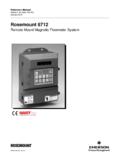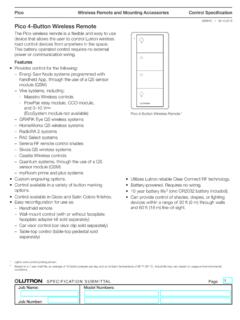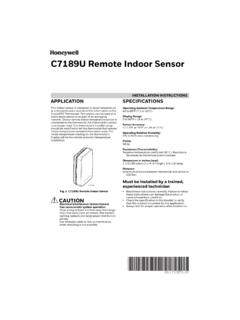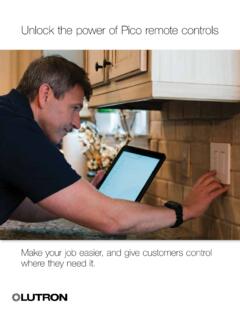Transcription of INSTALLATION AND OPERATION INSTRUCTIONS
1 MODEL: 1001 - AINSTALLATION AND OPERATION INSTRUCTIONSIF YOU CANNOT READ OR UNDERSTAND THESE INSTALLATION INSTRUCTIONS DO NOT ATTEMPT TO INSTALL OR OPERATEINTRODUCTIONThe transmitter operates on a 12V (A23) battery that is included. Install the 12V battery sup-plied with the unit into the battery compartment. It is recommended that ALKALINE batteries always be used for this product. Be sure the batteries are installed with the (+) and (-) ends facing the correct LED signal light should illuminate when either the ON or OFF button is pressed. If the signal light does not illuminate, check the position of the transmitter s battery, and if the bat-tery is fully 4/15/11 Page 1 This remote control system was developed to provide safe, reliable, user-friendly remote control system for gas heating appliances. The system can be operated manually from the the (4) AA-size batteries supplied with the unit.
2 It is recommended that ALKALINE batteries always be used for this product. Be sure the batteries are installed with the (+) and (-) ends facing the correct : will manually turn on the : will allow use of handheld transmitter. If the system does not respond to the transmitter on initial use, check the battery positions in the remote . If that does not work, see the SECURITY CODE section. OFF : will disable the remote is suggested that the slide switch be placed in the OFF position if you will be away from your home for an extended period of time. REMOTEONOFFLEARNR equires 4-AA batteriesLearning buttonRemote ReceiverBattery cover slides on/offSlideSwitchONREMOTEOFFThe remote receiver has a 3-position slide switch for selecting the mode of OPERATION ON/ remote /OFFS kytech 1001-AINSTALLATIONThe remote receiver can be either wall-mounted in a standard plastic switch box (not metal) or placed on or near the fireplace hearth.
3 Preferably, the remote receiver should be wall-mounted in a plastic switch box, as this will protect its electronic components from the heat produced by the gas appliance. The remote receiver should be kept away from temperatures exceeding 130 F. Battery life is also significantly shortened if batteries are exposed to temperatures 130 F or INSTALLATION make sure the remote receiver slide switch is in the OFF position. After INSTALLATION be sure that the slide switch is moved to the remote THE remote RECEIVERP osition the receiver as shown in diagram to the left with lower tab on cover plate inserted into groove of receiver (Make sure LEARN hole on cover plate properly aligns with remote receiver). Pull receiver up and snap into top tab of cover the cover plate so the word ON is fac-ing up; then, install the remote receiver into the plastic switch-box using the two long screws provided.
4 Push the white button over the re-ceiver slide switch. remote ReceiverCover Plate(Rear View)To attach Cover Plate to Receiver Box:REV 4/15/11 Page 2 REMOTEONOF FLEARNWAL LPlastic Switch BoxCover PlateReceiverSlideButtonHEARTH MOUNTThe remote receiver can be placed on the fireplace hearth or under the fire- place behind the control access panel. Use the wires attached to the remote receiver to connect to the gas valve or the electric module (piggyback connectors have both male & female terminals for flexibility).Be sure that the connectors do not touch each other or other bare metal surfaces; this will cause the appliance to turn on. The connectors may be wrapped with electrical tape to prevent MOUNTWhen wall mounting the remote receiver, longer wires (not included) are required to connect to the gas valve or electronic module.
5 These wires must:Be at least 18 Gauge (AWG) Be no longer than 20 Have no splices WARNINGThis remote control system must be installed exactly as outlined in these INSTRUCTIONS . Read all INSTRUCTIONS completely before at-tempting INSTALLATION . Follow INSTRUCTIONS carefully during INSTALLATION . Any modifications of this remote control or any of its compo-nents will void the warranty and may pose a fire not connect any gas valve or electronic module directly to 110-120 VAC power. Consult gas appliance manufacturer s instruc-tions and wiring schematics for proper placement of all wires. All electronic modules are to be wired to manufacturer s following wiring diagrams are for illustration purpose only. Follow INSTRUCTIONS from manufacturer of gas valve and/or electronic module for correct wiring procedures. Improper INSTALLATION of electric components can cause damage to electronic module, gas valve and remote receiver.
6 Skytech 1001-AELECTRONIC SPARK SYSTEM CHECKS lide the 3-position button on the remote receiver to the ON position. The spark electrode should begin sparking to ignite the pilot. After the pilot flame is lit, the main gas valve should open and the main gas flame should the button to OFF. The main gas flame and pilot flame should both the button to remote , then press the ON button on the transmitter to change the system to on. The spark electrode should begin sparking to ignite the pilot. After the pilot is lit, the main gas valve should open and the main gas flame should TRANSMITTER TO RECEIVER Each transmitter uses a unique security code. It will be necessary to press the LEARN button on the receiver to accept the trans- mitter security code upon initial use, if batteries are replaced, or if a replacement transmitter is purchased from your dealer or the factory.
7 In order for the receiver to accept the transmitter security code, be sure the slide button on the receiver is in the remote position; the receiver will not LEARN if the slide switch is in the ON or OFF position. The LEARN button in located on the front face of the receiver; inside the small hole labeled LEARN. Using a small screwdriver or end of a paperclip gently press and release the black LEARN button inside the hole. When you release the LEARN button the receiver will emit an audible beep . After the receiver emits the beep press ANY transmitter button and release. The receiver will emit several beeps indicating that the transmit-ter s code has been accepted into the 4/15/11 Page 3 WIRING ELECTRONIC SPARK IGNITIONSELECTRONIC MODULETRTHREMOTERECEIVER neutral wire24 VAChot wire120 VAC110/24 VACT ransformerThe remote control receiver can be connected, in series, to a 24 VAC transformer to the TR (transformer) terminal on the ELECTRONIC MODULE.
8 Connect the hot wire from the 24 VAC transformer to either of the wire terminals on the remote receiver. Connect another wire be-tween the other receiver wire terminal and the TH (thermostat) terminal on the ELECTRONIC INSTRUCTIONSA qualified electrician should install the remote control BLOCKON MILLIVOLTGAS VALVESTHTPTPTHTHERMOPILE/PILOT LIGHTREMOTERECEIVERC onnect one wire from the remote receiver to the TH terminal on the gas the other wire from the remote receiver to the TH/TP terminal on the gas MILLIVOLT VALVESMILLIVOLT SYSTEM CHECKE nsure that the pilot flame is lit. Slide the 3-position button on the remote receiver to the ON position. The main gas flame ( , the fire) should ignite. Slide the button to OFF. The main flame should extinguish (the pilot flame will remain on).Slide the button to remote , then press the ON button on the transmitter to change the system to on.
9 The main gas flame should 1001-AFCC REQUIREMENTSNOTE: THE MANUFACTURER IS NOT RESPONSIBLE FOR ANY RADIO OR TV INTERFERENCE CAUSED BY UNAUTHORIZED MODI-FICATIONS TO THE EQUIPMENT. SUCH MODIFICATIONS COULD VOID THE USER S AUTHORITY TO OPERATE THE EQUIPMENTFor Technical Service, INQUIRIES888/672-8929 or 260/459-1703 Web site: INQUIRIES877/472-3923 MANUFACTURED EXCLUSIVELY FOR SKYTECH II, INCREV 4/15/11 Page 4 TRANSMITTER WALL CLIPThe transmitter can be hung on a wall using the clip - Drill 1/8 pilot holes and install with screws provided. Plaster/Wallboard - Drill 1/4 holes, use a hammer to tap in the two plastic anchors, then install with the screws CLIPSLOTWALL CLIPBATTERYCOMPARTMENTBATTERY LIFELife expectancy of the alkaline batteries in the transmitter and receiver should be at least 12 months. Check and replace all batteries:Annually.
10 When operating range becomes reduced. When transmissions are not received by the remote receiver. If the remote receiver batteries measure less than volts (all four batteries in combination). If the hand held transmitter battery measure less than volts. TROUBLE SHOOTINGIf you encounter problems with your fireplace system, the problem may be with either the fireplace itself or with the remote . Review the fireplace manufacturer s OPERATION manual to make sure all connections are properly made. Then check the OPERATION of the remote in the following manner:Make sure all batteries are correctly installed in the transmitter and receiver. Also check that the batteries are fully charged. Check batteries in transmitter to make sure contacts are touching (+) and (-) ends of battery. Bend metal contacts in for tighter fit.








